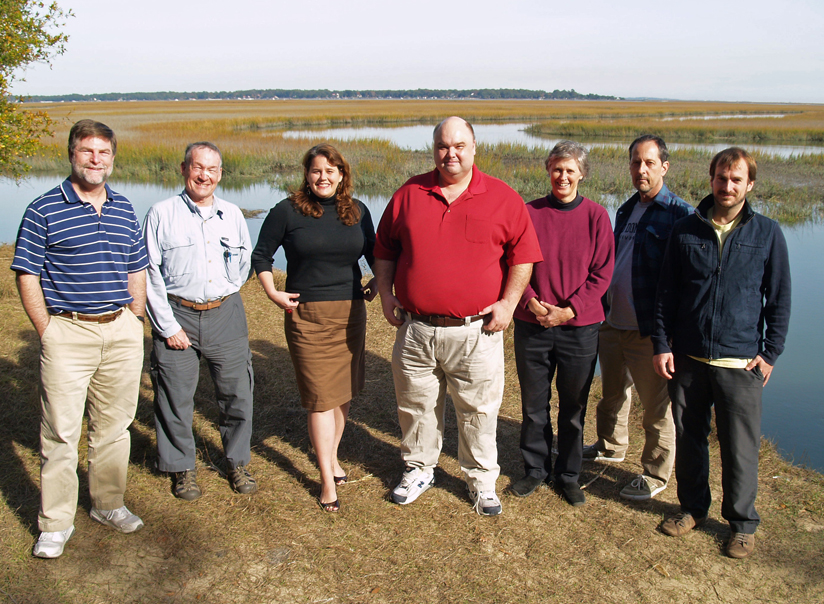Salt marshes are a vital part of the coastal ecosystem. They provide a nursery for many kinds of marine animal life. Sitting in the transition zone between the ocean and the land, salt marshes serve as a physical buffer against severe weather. They act as a chemical buffer by capturing, holding and releasing nutrients that are brought in on each tide. As a result, the marshes have a great influence on the type and amount of nutrients that enter the sounds and the ocean. That buffering capacity varies on tidal, daily and seasonal time scales, but how it functions is poorly documented.
A team of Skidaway Institute of Oceanography scientists have begun a project to get a clearer picture of how salt marshes function and interact with their surrounding environment.
The composition of the science team reflects the interdisciplinary nature of the project. Principal investigator Jay Brandes, Aron Stubbins and Bill Savidge are chemical oceanographers, and Catherine Edwards is a physical oceanographer. Geologist Clark Alexander and physical oceanographers Jack Blanton and Dana Savidge are also contributing to the effort. The three-year project is funded by a $699, 971 grant from the National Science Foundation.

The research team at Groves Creek (l-r) Clark Alexander, Jack Blanton, Catherine Edwards, Jay Brandes, Dana Savidge, Bill Savidge, Aron Stubbins
“Scientists have looked at salt marshes in the past and have gotten some good data,” Brandes said. “However, this will be the first detailed look at the combined functions of one of these marsh systems.”
The project will focus on Groves Creek, a portion of coastal salt marsh along the Wilmington River, adjacent to the Skidaway Institute campus. Groves Creek has been the site of other research projects. Over the past three years, Blanton, Alexander, Dana Savidge and others have studied the topography and water-flow in the marsh as part of a Department of Energy-funded project. Because of this, the physical layout of the marsh has been documented to a fine detail.
“We already know a lot about this area, especially how the water moves in and out of the marsh on the tides,” said Brandes. “We have a very good understanding of the topography of the top of the marsh and its tidal creeks, both above and below the surface.”
The scientists also believe the Groves Creek area is fairly representative of salt marshes along the Georgia and South Carolina coasts.
From a chemical standpoint, the research will focus on way the salt marsh uses carbon: is it a consumer or producer of carbon-based organic material and nutrients?
“Marshes take material in from the river on every high tide, and they deliver material back to the river on the falling tide — but it isn’t the same stuff,” Savidge said. “The marsh changes the river chemistry on every tidal cycle.”
There isn’t much consensus on what controls that exchange between river and marsh. “That is one of the big questions,” said Brandes, “Trying to understand whether the marsh is a producer or consumer, and how that changes over time, the seasons, the tides and so on.”
To get a detailed history of marsh-river exchange, the scientists will place sensors in the marsh that will measure various conditions every 15 minutes. Remote sensors cannot measure everything, so the research team will also be collecting samples on a daily basis and returning them to their labs for analysis. Understanding the big picture will come from adding up all the little incremental changes over time and relating them to the actions of sun, tide and weather on the marsh surface.
Stubbins will focus his efforts on the role of dissolved organic carbon in the marsh. Savidge will work look at how the salt marsh uses dissolved oxygen. Edwards will be modeling how water flows in and out of the system and how that movement interacts with the chemical and biological activity.
When the project is complete in three years, the Skidaway scientists expect to have a much more extensive picture of the role salt marshes play in the larger coastal ecosystem.
nutri


